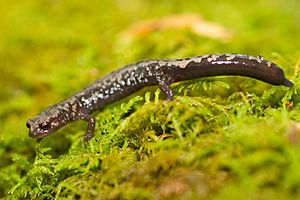Weller's salamander facts for kids
Quick facts for kids Weller's salamander |
|
|---|---|
 |
|
| Conservation status | |
| Scientific classification | |
| Genus: |
Plethodon
|
| Species: |
welleri
|
Weller's salamander (Plethodon welleri) is a small type of salamander. It belongs to the family called Plethodontidae. These special salamanders live only in the mountains of the southeastern United States. You can mostly find them near Grandfather Mountain in North Carolina. They have cool metallic spots that make them stand out. They like to live in cool, rocky forests. Sadly, these salamanders are currently in danger because their homes are being broken up and damaged.
Contents
What Does a Weller's Salamander Look Like?
Weller's salamanders are small and slender. They have 16 grooves on their sides, called coastal grooves. Their backs usually have dark gold, shiny markings. These salamanders have webbed toes.
Like other salamanders in their family, they can do something interesting when scared. They might release a sticky, bad-tasting liquid from their skin. Sometimes, they even pretend to be dead. This trick helps them avoid being eaten by predators.
What Do Weller's Salamanders Eat?
Weller's salamanders are insectivores. This means they eat insects and other small creatures. Their diet includes tiny animals like pseudoscorpions, spiders, ticks, mites, and springtails. They also munch on true bugs, butterflies, moths, flies, and beetles.
Where Do Weller's Salamanders Live?
This type of salamander lives high up in the southern Blue Ridge Mountains. Their main home is in northwest North Carolina. You can also find them in parts of Tennessee and Virginia where these mountains stretch.
However, they only live in a few specific counties. These include Johnson and Unicoi Counties in Tennessee. In North Carolina, they are found in Yancey County. They also live on mountains like Mount Rogers and Whitetop Mountains in Virginia. You can find them on the Unaka Mountain ridges in Tennessee and North Carolina too.
Weller's salamanders prefer cool, shady forests. They especially like spruce and birch trees. Some have also been found in hardwood forests higher up. They often hide under logs, stones, and flat rocks.
Reproduction and Life Cycle
Weller's salamanders usually breed in the spring and fall. Scientists have seen them courting in October and April. Female salamanders are ready to have babies when they are about 3 years old. They are also about 35 millimeters long. Males can breed when they are 2 to 3 years old and about 30 millimeters long.
Female salamanders lay clutches of 4 to 11 eggs. These eggs are laid in tight groups, hanging from a stalk. They often make their nests under moss mats on conifer logs. You can see these eggs from mid-August to September. Each egg is between 2.6 and 6.5 millimeters wide.
When the baby salamanders hatch, they look like tiny versions of the adults. They don't have gills like some other salamander babies. This is called direct development. It means they skip the tadpole-like stage. Some evidence shows that the mothers stay and guard their eggs. Females found guarding nests often look thin. This suggests they don't eat much while protecting their eggs. The eggs themselves are dark because they have a special pigment.
Protecting Weller's Salamanders
Some larger groups of Weller's salamanders seem to be doing well. These are the ones on Grandfather Mountain and Mount Rogers. But in North Carolina and Virginia, their numbers seem to be going down.
The different groups of salamanders are separated from each other. This is called fragmentation. It makes it harder for them to find mates and stay healthy. Their high mountain homes offer some protection. Much of their habitat on Mount Rogers is a national recreation area. This means the land is protected. The area around Grandfather Mountain is privately owned but also seems safe.
However, because these groups are so small and isolated, they are at risk. Things like fires or more habitat damage could cause them to disappear. The biggest threats to Weller's salamanders are their homes being damaged or lost. This often happens because of new buildings and logging.


